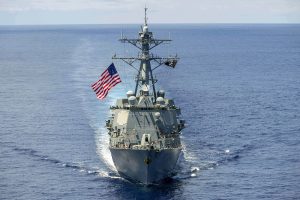Admiral Wu Shengli, the current commander of the Chinese People’s Liberation Army-Navy (PLAN), and Admiral John Richardson, the U.S. Navy’s Chief of Naval Operations, will hold an hour-long video conference on Thursday, two days after the United States sent a guided-missile destroyer within 12 nautical miles of a Chinese artificial island in the South China Sea, to discuss current tensions in the region.
The meeting will be the first high-level interaction between U.S. and Chinese senior military leaders over tensions in the Spratly Islands since the patrol by the USS Lassen on Tuesday, October 27. The USS Lassen, accompanied by P-8A Poseidon and P-3 Orion surveillance aircraft, asserted high seas freedoms within 12 nautical miles of Subi Reef in the Spratly Islands.
The conversation between Wu and Richardson will focus on the freedom of navigation patrol and on related issues. China’s Ministry of Defense notes that Wu will present China’s “solemn position on the U.S. vessel’s entry without permission,” echoing language used by the Chinese foreign ministry. According to Reuters, Thursday’s video conference will be the third of its kind between the top officers of both the U.S. Navy and the PLAN.
High-level military-to-military interactions are not an unusual occurrence between the United States in China. In recent years, amid high tensions in the South and East China Seas, Chinese and U.S. officials have discussed areas of disagreement shortly after major incidents that had a potential to escalate into a broader misunderstanding.
In December 2013, after an incident involving the USS Cowpens, another Arleigh Burke-class guided missile destroyer, U.S. and Chinese officials met to forge an understanding on what precisely had occurred. In August 2014, officials from both sides met to discuss unsafe air intercepts and how aerial encounters should be handled by pilots from both sides. Both incidents and the ensuing military-to-military talks led to broader accords, including an April 2014 agreement on unplanned encounters at sea and a similar understanding on air-to-air encounters during Chinese President Xi Jinping’s 2015 state visit to the United States.
The Chinese reaction to Tuesday’s patrol has been largely restrained though both the foreign and defense ministries have issued sharp statements noting their disapproval of the U.S. patrol. Across the broader region, U.S. partners and allies have welcomed the U.S. Navy’s assertion of high seas freedom near China’s man-made islands that were originally fully submerged at low tide. U.S. officials have indicated that these patrols in the South China Sea will be a regular occurrence going forward.

































